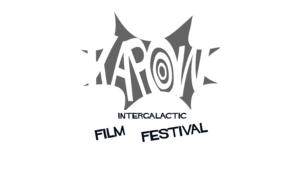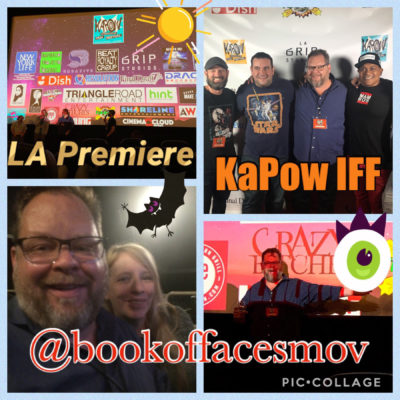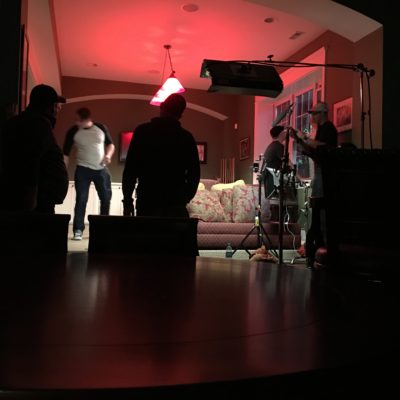Many great people have championed our project, including Chicago Filmmaker and Bloody Bites curator Tony Wash. He has selected The Book of Faces to be in the next episode of Bloody Bites on the Roku streaming app. Bloody Disgusting is expanding their horror footprint into many new platforms and partnerships. We are very grateful and honored to be selected by them. We will post airing dates soon.

Screening Thurs. Oct. 27th at Big Picture Chicago Halloween Showcase! LINK


Synopsis: 'TheBook of Faces' is a story about using video chats for seances; your children can now commune with the devil from their bedroom. Scary, right? And that is key, good horror is about our base fears. This film is about the devil and technology run amuck; fears that appeal to all corners of the Earth. Five teenage 'friends' go online pursuing an urban legend...

The Book of Faces was on the big screen in the city that never sleeps. We had a great showing in August, at MegaFest/Action on Film, sharing our filmmaking journey with people from all over the world. Our sci-fi horror film intrigued everyone, and they all wanted to see what was next for our desktop horror property. We had many meetings discussing filming stories in Canada.

Oregon Scream Week Horror Film Festival is one of our favorite festivals. The City of Portland, Oregon, should be thankful they have passionate arts patrons like Mikel Fair. He and his staff put on a great fest and refuse to let COVID stop the show!
They honored THE BOOK of FACES with BEST EDITING at the festival. Creating a video chat story presents many challenges, and editing five or more video clips, to work together, is one of the most arduous tasks. Scream Week judges recognized editor Rus Robert Blemker’s work gathering all the actor performances into an intense and scary film. We are very thankful for this award! You can see the announcement video here: https://www.facebook.com/OregonScreamWeek/videos/345592043329342

The Book of Faces won Best Experimental Film during a highly entertaining VAiFF online film festival. We had a great LIVE WORLDWIDE INTERVIEW where Rus Blemker talked about the outstanding work of our cast & crew. The work of the other filmmakers in our category was exceptional ~ it honors us to be part of this international group. The entire festival was very professional, and we have sent this video to all parties interested in our FULL FEATURE of THE BOOK OF FACES!!

With our win in Italy ‘The Book of Faces’ will be at Action on Film Megafest in Las Vegas! https://www.actiononfilmfest.com/megafest. A film about the dark underbelly of social media must be shown in Sin City. I look forward to visiting the good people at this writers & filmmaker event and meeting up with AleX from X-World, Italy. It will be a great time to share our vision for THE FULL FEATURE!! See you on The Strip July 23rd ~ August 2nd.
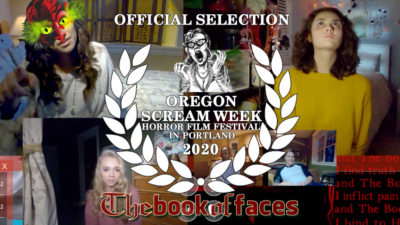
The good people at Oregon Scream Week Horror Film Festival Selected @bookoffacesmov for their March 14th Event!! It looks to be a full day of incredible horror shorts!! I can’t wait to see Portland, Oregon; I have been wanting to visit for a long time.

Finding local festivals to share our proof of concept is close to our heart. Our blood soaked… pulsing…dark…heart… Our next victims will be the juicy people at Chicago Independent Film and TV Festival as ‘The Book of Faces’ is now an OFFICIAL SELECTION for their March event. https:ChicagoIndependentFilmFestival SITE They have a proven track record of throwing a vicious party, screening great work from local content creators pushing the limits with hypnotic raGe iNdUCing ImAGEs!!! (I have to take my meds… breath…breath) What we want to say is “Thank you CIF+TV! We are so happy to be a part of your event, talk shop, share art and grow together.” More information to come, please spread the word as we work to bring the feature version of our film to life: @bookoffacesmov

The Book of Faces –our short horror film & proof of concept for a full feature — is in another great Midwest film event. We’re very excited to be a part of the awesome Muscatine Independent Film Festival along the banks of the mighty & murky Mississippi River! https://muscatinefilmfest.com The event is the weekend of November 8th – come join, more to come!

We had so much fun at the KaPow Intergalactic Film Festival meeting filmmakers, fans and friends we did not want to leave. Turns out we should have stayed as the festival honored ‘The Book of Faces’ with –Best Horror Short Film– From the great Chicago cast & crew we are very thankful for this award and having such a great venue to make our Los Angeles Premiere. We can’t wait to come back! Please spread the word as we work to bring the feature version of ‘The Book of Faces’ to life: @bookoffacesmov

The KaPow IFF has been so good to us, the crowds and venue are awesome. We are looking forward to seeing everyone at our screening tonight: Part of the Wild Worlds Block, Tuesday, Sept. 17th at 8PM. Here is the LINK: https://www.laemmle.com/film/kiff-wild-worlds-block

We are coming to LA with ‘The Book of Faces’ as part of the KaPow Intergalactic Film Festival. The screening is Tuesday ~ September 17th, 8pm at the NOHO 7 5240 Lankershim Blvd. North Hollywood, CA 91601 Telephone: 310-478-3836
Here is the LINK for tickets to our screening: https://www.laemmle.com/film/kiff-wild-worlds-block
Here is the LINK to the entire fest: https://kapowiff.com
Hope to see you there!

We have received word that ‘The Book of Faces’ will be playing at X World Short Film Festival this December. Oh how I long to return to The Colosseum, Tivoli Fountain- THE VATICAN!! In all seriousness we are very honored to share our film property with the European Continent, more to come.

We are traveling to the KAPOW Intergalactic Film Festival, Sept. 13th – 19th., to make our LA Premiere! https://kapowiff.com
Sharing this new horror property with our friends and colleagues in LA is very exciting. It happens at an awesome festival run by terrific people ~ more to come!

The Book of Faces is an Official Selection of The ScareFest 2019 in Lexington KY, Sept 12-15th. https://thescarefest.com
So thankful to these great people and looking forward to celebrating film together!
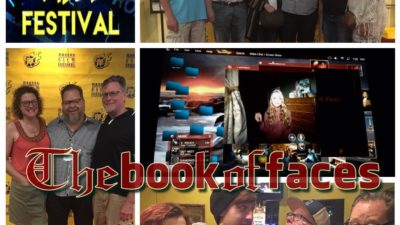
Please join us for the premiere of The Book of Faces! Part of an excellent 40min film showcase from Rus Robert Blemker and Konee Rok.
About this Event
This is the official premiere and cast & crew party for Rus’s The Book of Faces. We want to celerbrate our festival run with friends and fans.
- The showcase features an entertaining mix of music videos, shorts and comedic bits from both artists.
- Good libations and appetizers will be served at a private event across the street.
- Chicago Filmmakers is a beautifully restore historic firehouse with a state of the art theater. Chicago Filmmaker’s Lobby is off Hollywood Ave.
- There is not parking at the theatre, there is a lot of street parking on Clark St. and Broadway Ave. – a pleasent walk to the theater. The Bryn Mawr Redline Stop is a few blocks away.
- We will have a Photocall before + a post screening Q&A and PaRtY!! This private PaRtY will be in the space at 1307 West Hollywood – across the street.
- Business casual dress but we will not stop those from showing off!!
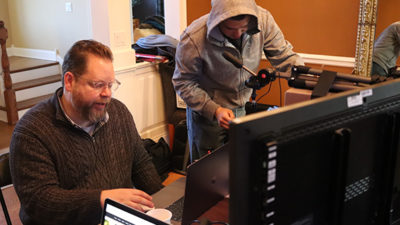
I have been obsessed with the ‘one room drama’ for a long time. It is a way to control a film project’s budget by finding a story that can exist entirely in one setting. This may seem simple on the surface but without the freedom of visual variety these films can become very tedious for the audience very quickly.
The economics of independent film practically dictate this approach as few first time writer / directors get anything more than a couple hundred thousand dollars for their feature. I’ve experienced film friends struggling to get larger budgeted, multiple location features off the ground. I’ve worked on independent features with many locations and no money; every moment is an epic struggle between quality and schedule. There is a feeling the entire project could fall apart at any moment. It’s rare these productions allow the writer / director to capture the story and performance they originally envisioned.
Traditional low budget features allow the teams to grab simple visual variety by sending their hungry cinematographers out to film the surroundings. This can be both a blessing and a curse; you can get quick ‘filler’ for your shoestring feature, but if the primary performances and visuals are not up to par these lovely exteriors will not save your movie.
I will say from experience that writing a ‘one room drama’ is very difficult. You are essentially writing a play; if as a writer if your characters are not full of personality and you do not know them inside and out you will fail. There is no place to hide when the story, plot, and drama starts to put your audience to sleep. The good news is there are hundreds of well-written plays and film scenes to inspire and teach you. I took it as a challenge to find stories that can be told in a smaller setting while still having the emotional impact of larger films.
I’ve also understood for a long time that a horror film is the easiest genre to get off the ground and sale. Many of my film heroes, like Sam Raimi and Peter Jackson, got there start by creating fun and innovative independent horror. I do not come by this genre naturally but over the course of writing and studying horror films the genre has risen to the level of the western genre in my book. Both are stripped down morality plays where the settings allow the audience to mainline adrenaline and escape the real world.
I have drawers full of uncompleted treatments for ‘one room dramas’. There are stories that take place inside a mega nightclub, a hostage cell, and the ubiquitous haunted house… All of them are good but none of the ideas excited me. I have been tooling with ‘micro horror’ for some time; the idea that universal fears primarily existing within and around one’s body and there are untapped stories to be told.
As soon as video chat became ‘a thing’ I was fascinated with how this new communication device could be use in micro horror. I have files on my computer that predate all the major desktop / video chat films that have been released over the years. Many of the ideas in these films are in my discarded file. I’m not being braggadocios, the ideas were just not me. After many years, and many debates with film friends, I settled on pursing my version of a desktop video chat as my independent ‘one room (horror)’.
I developed the characters and surrounding mythology for ‘The Book of Faces’ property. A feature length screenplay was created along with comp art. (I like to work this way moving back and forth between the written and visual worlds) Once I felt the feature length screenplay had ‘enough meat’ to pursue its production I selected a few of the feature’s ideas to be developed in to a short version.
Again my logic side comes in to play here, I have donated and been involved in many independent film fund raising campaigns; I’m a strong believer that a proven proof of concept is a more powerful generator of funds than the common ‘promise videos’. I decided to follow the great Damien Chazelle by producing a short version of your feature as a way to gain interest in the longer version.
I got the short screenplay together and assembled a crew. I moved heaven and earth to find the right cast and one home that could work for multiple bedrooms in different locations. I spent the extra money to shoot my video chat film like we would the feature version. I knew having the actors reacting to each other in real time through seamless microphones and monitors would gain us authentic performances. This more expensive direction goes back to the ‘one room drama’ dilemma were you have nowhere to hide and must capture authentic performances to keep the audience’s attention. Furthermore, you need to maximize the ‘one rooms’; your limited locations better have top-notch art direction and lighting.
So I pulled it off (I don’t know how I pulled it off) in one long January weekend we got our short version of ‘The Book of Faces’ captured. I was exhausted and elated, scared and relieved.
Then the editing began and I CAN FINALLY GET AROUND TO MY TOPIC, lol! I’ve come to realize that the choice to do a ‘one room drama’ as a video chat film is not as cheap as I originally thought. All the capital saved during production, both monetarily and time, has been added to the postproduction phase of the film. I completely under estimated the amount of time and RAM a video chat films takes up. Five video strings on the screen at once require a ‘beefy’ editing system with solid state drives. The level of precision required in crafting the desktop environment, with all the associated bells and whistles, in this genre is tedious. I relate to the director of the desktop film ‘Searching’ stating in a Q & A that he, “Never wants to do a desktop film again!”
Live and learn, as we finish our short version of “The Book of Faces’ I still believe it is a great story and worthwhile project. I am now aware that the budget for the feature version will need a more realistic postproduction team and equipment. A more traditional ‘one room drama’ with one camera would not need this added expense. Live and learn.

Gabriella has been acting since the age of five. She loves meeting new people on set and making lasting friendships. Her dream is to be cast on a comedy show because she loves to act silly. She studies acting with a private coach as often as possible. Gabby wants to go to college to study history in hopes of becoming an archaeologist. Not only does she act but she is does competitive power tumbling, trampoline and double mini placing 5th in the nation for tumbling two years in a row.
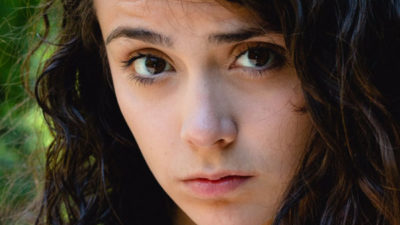
Magdalena has known she’s wanted to act since the age of 3 when her parents rented the VHS tape of CATS the Musical. After making this discovery she went on to dance ballet for 10 years, then was a part of her local theatres Youth Company all throughout high school where she participated in many children’s shows. Now, since going to college at Columbia College Chicago she has learned she also enjoys the art of On-Camera acting. She now seeks to mostly do On-Camera work and is loving it.

Chicago based Amelia and has always dreamed of becoming an actor. She has played leading roles in a number of short films, and has appeared in TV and print campaigns for many prominent companies. This year, Amelia has acted in two films, ‘When Are You Leaving?’ (lead), and ‘The Book of Faces’ (supporting), while sharpening her comedic skills with The Second City Teen Ensemble. She is an honor roll student, varsity softball and cross-country athlete, Student Ambassador, tutor, and mentor. Amelia also spends her time volunteering for Catholic Charities across the Chicagoland area.

Audrey developed a passion for acting at the age of nine. At the age of 14 she was the Lead actor for a children’s ministry, where she shared her love for the Lord through acting, singing, and dancing. Some of her favorite roles include Rebecca in the Book of Faces and the young Dina on the Young and Restless. Audrey is currently studying acting at the University of Indianapolis in Indiana. It is her goal in the near future to work TV and film full-time.

Watching a movie simply wasn’t enough. At the end of a film, Dionte HAD to watch the deleted scenes, and the bloopers. He wanted to know everything that went into a scene. He wanted to portray that fictional character that no one forgets, and most importantly, he wanted to have fun doing it. Since middle school, Dionte had the desire to act, but didn’t satisfy that urge until his college years. Since then, he has been in a musical, an independent film, and numerous short films. Acting has awaken a passion in him that keeps him up at night wanting to perfect his craft.

Philip is a Chicago based actor with a theatre background in performance. "My first show in Chicago was in 2014, Snow White and the 7 Drag Queens. I left home to tour the U.S., Canada, and Europe with, Marvel Universe Live, as Thor. Recently, I was involved with the Lyric Opera for their productions of La Boheme, IL Trovatore, and Electra.

Rus creates innovating films and commercials in Chicago. The changing world fuels his desire to write stories that entertain and provoke thought. Altered realities, like ‘The Book of Faces’, occupy a large portion of his original screenplays.
Rus understands that a first feature needs to be budget conscious without sacrificing story and character. ‘The Book of Faces’ shows his understanding of the one room drama and how to create a satisfying economical movie.
This is a proof of concept for both audience members and producers. Rus’s investment proves the feature will succeed; his passion and leadership will deliver a powerful feature.

Jason was raised on a hearty diet of Hollywood classics and b-movie horror films growing up. This led him to follow his boyhood dream of film at Columbia College, Chicago where he studied cinematography. Jason has worked on several award winning projects including, Root Canal and Back to Reality, which Kevin Smith praised for it's photography. Jason is also an accomplished DJ who tours the Midwest.

I am a media artist; Utilizing cameras, lights, editing, motion graphics, visual effects, and animation I create visual experiences- I have spent my life since childhood learning how to create every piece of a film, from pre-production through shooting or animating and all the way through post. My focuses now are primarily in Motion Graphics, Animation and Visual Effects.
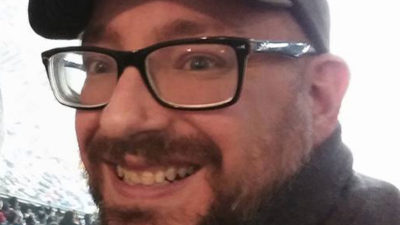
There
a thousand ways to illustrate and animate your idea. Bring it to me, and I'll
make it spin, flip, walk, levitate and morph. What ever it takes to communicate
your message and grab your audiences’ attention.
If it's visual effects
you’re looking for, go no further. I'm like John Knoll (look him up), but bit
more affordable.
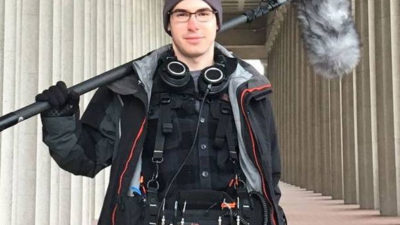
Kris is an audio engineer who is detail oriented and strives for client satisfaction. Kris received his education in Recording Arts from Tribeca Flashpoint College. He has had a vast array of experience working on projects such as Chiraq the series, various television commercials and several Indi features. He also has a background in live sound working with JBTV where he has had the pleasure of working with bands such as The Mowglies, AwolNation, Torche and many more.



